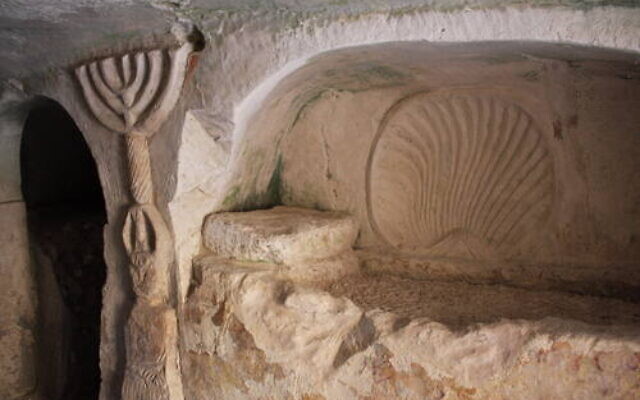The Option of Being Buried in Israel
For many Jews today, being buried in Israel is a statement of eternal attachment to the Jewish homeland.
Chana Shapiro is an educator, writer, editor and illustrator whose work has appeared in journals, newspapers and magazines. She is a regular contributor to the AJT.
Burial in Israel is considered a virtuous practice, to the extent that it is customary to include a little earth from Israel in the coffins of Jews buried in the Diaspora. The tradition of burial in the Holy Land is grounded in a number of Jewish sources, the best-known being from Midrashic teachings that when the Messiah arrives, all Jews will be resurrected, starting with those buried in Israel.
In the Torah, the practice is modeled by the patriarch Jacob, who insists that his son Joseph swear to not bury him in Egypt, but instead bury him with his ancestors — a reference to Abraham’s purchase of the cave at Machpelah in Hebron as a family tomb. The Book of Genesis records the measures that Jewish patriarchs took in order to be buried there.
Two generations after Abraham, Jacob instructs his children, “Bury me with my fathers in the cave which Abraham bought, where they buried Abraham and Sarah, his wife, and Isaac and Rebecca, his wife, and where I buried Leah.” Jacob’s offspring — that is, his daughter and twelve sons — honored their father’s wishes and buried him in Israel, while they and their families remained in Egypt for the rest of their lives.
Though exhuming the body of a Jew is very rare, it is allowed in the case of re-burial in Israel. Jacob’s son, Joseph, in his own old age in Egypt, left this legacy: “You must bring my bones out of here.” Nearly 200 years after he died, Joseph’s bones were carried out of Egypt by Moses and the Israelites. Jewish sage Moses Maimonides states that the bones of Jacob’s daughter, Dina, and her brothers, the fathers of all twelve tribes, were also brought for burial to the Land of Israel.
For many Jews today, being buried in Israel is a statement of eternal attachment to the Jewish homeland. One cemetery popular among foreign Jews is Eretz HaChaim, which is located near the city of Beit Shemesh, a 40-minute drive from Jerusalem. Americans make up the largest group buried there, according to Jonathan Konig, who assists the cemetery’s burial society. Eretz HaChaim plots cost about $11,000, in addition to a $1,500 one-time maintenance fee. The cemetery organizes transportation and other necessary services, from arrival at Israel’s Ben Gurion Airport, for $2,200. Before the flight to Israel, clients must also pay steep additional fees for a range of necessary permits, transporting the body to New York, and services performed there, including “taharah,” the purification and preparation of the body of the deceased. Pre-pandemic, El Al charged about $2,300 and United about $2,900 to fly a casket and body to Israel. That does not include flights for family members who wish to attend.
Rabbi Binyamin Hammer, the National Council of Young Israel’s director of rabbinic services, notes, “The success of the day school movement has caused a tremendous amount of aliyah from America. People say, ‘If I can’t live there, at least let me be buried there.’” His colleague, Rabbi Yehudah Prero, adds, “Many people feel that if they pass away in a certain city, their kids and future generations may not continue to live there. But if they’re buried in Israel, they believe their gravesite will be visited.”
Plots can be purchased directly from a cemetery, but it’s easier to use an intermediary. A number of American synagogues and Jewish organizations own blocks of cemetery plots in Israel that are reserved for their members, including Congregation Beth Jacob in Atlanta.
Eddie Dressler, of Dressler’s Jewish Funeral Care, has assisted families with burials in Israel for many years to ease the difficulties surrounding the stressful experience. Dressler explains, “Because we know what’s required to bring someone to Israel for burial, we’re familiar with all the paperwork required, and we streamline the complicated process. We follow the family’s lead to make things proceed smoothly.”
In Mishnaic and Talmudic times (200-600 CE), Jewish burials took place in caves, carved tombs, sarcophagi, and catacombs. The tomb most typical of that period is a natural cave or chamber cut into soft rock, sometimes connected with a network of tunnels, where generations of the same family would be buried. The Israeli newspaper Haaretz recently reported that there is no more room in the largest cemetery in Jerusalem, Har Hamenuchot, where hundreds of thousands of graves have now filled every corner of this mountain. The cemetery’s burial organizations have resorted to multi-storied burials, on four to six levels, while also burying people in niches carved into the rocky walls. New structures are currently being erected to accommodate future burials in massive underground catacombs in order to meet the increased demand. One wonders how Americans will react to this option, which may someday be replicated in other cemeteries.
- Senior Living
- Community
- Chana Shapiro
- Land of Israel
- Book of Genesis
- Midrash
- Machpelah
- Hebron
- Jerusalem
- Egypt
- twelve tribes
- Patriarchs
- Abraham
- Jacob
- Joseph
- Isaac
- Leah Rebecca
- Moses
- Israelies
- Mishnah
- Talmud
- Moses Maimonides
- Israel
- Eretz HaChaim
- Har Hamenuchot
- Cemetery
- Haaretz
- Congregation Beth Jacob
- burial
- catacombs
- tombs
- Jonathan Konig
- Ben Gurion Airport
- pre-pandemic
- El Al
- Rabbi Binyamin Hammer
- National Council of Young Israel
- Rabbi Yehudah Prero
- Eddie Dressler
- Dressler’s Jewish Funeral Care




comments